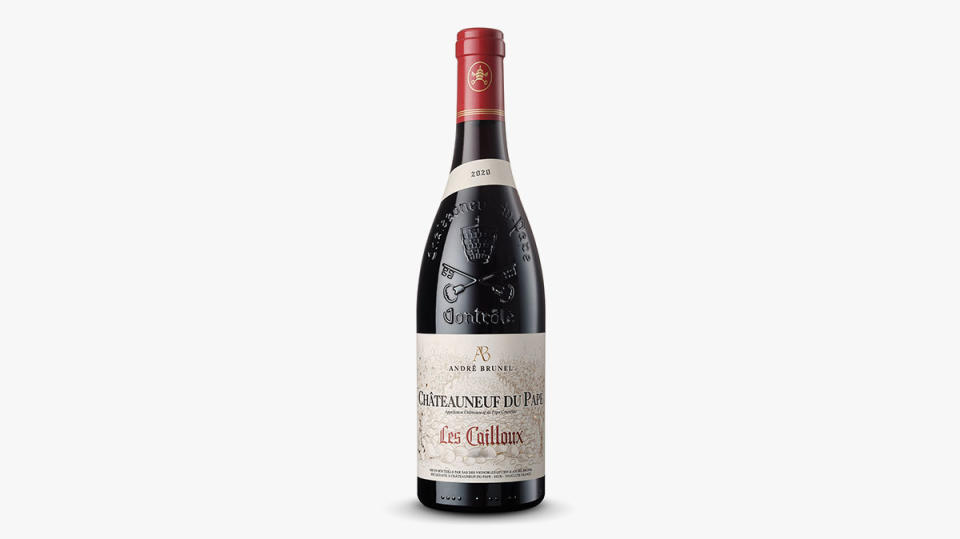How This Rhône Winemaker Is Crafting One of the Purest Expressions of Grenache Anywhere

Among the great wines of the world, Châteauneuf-du-Pape holds its own compared to the best bottles from Burgundy or Bordeaux. Taking its name from the palace in which the Avignon popes resided during the 14th century, Châteauneuf-du-Pape is where the French appellation system was first created in 1923. The region is home to mainly Grenache vines, which cover about 75 percent of its stone and clay soils, but 12 other red grapes including Syrah, Mourvèdre, and Cinsault are cultivated here and can be used in Châteauneuf-du-Pape wines. While this Rhône Valley AOC is known for bold and meaty reds with a firm touch of oak, Domaine André Brunel has been fermenting and aging its wines in stainless steel and concrete for many vintages, allowing the purity of its old-vine Grenache to shine through.
Long before a recently noted trend for a lighter touch of oak in red wines, André Brunel, who passed away in 2022, began minimizing barrel influence on his wines, a tradition his son Fabrice, eighth-generation owner and winemaker, is carrying on. He and his co-winemaker Romain Pitaud have transitioned to no oak at all on their highest end wine, the newly released Cuvée Centenaire 2022, which retails for $300. Made with 90 percent Grenache from vines planted by Brunel’s great-grandfather in 1889, it is an incredible example of the quality that can be coaxed from the stony terroir of Châteauneuf-de-Pape. Brunel points out that he adds Syrah and Mourvèdre for their aromatic profiles and for color.
More from Robb Report

At a recent tasting showcasing this new release and several back vintages of the domain’s “entry level” CdP, Les Cailloux, we were surprised to discover that the wine’s perfumed aromas and highly concentrated cherry and raspberry flavors with strong notes of spice were the result of careful vineyard selection and perfectly timed harvesting rather than being barrel-derived. The 2022 is a blend of 84 percent Grenache, 10 percent Mourvèdre, and 6 percent Syrah; Cuvée Centenaire is only produced in excellent vintage years. This bottling is just hitting our shores, and we can assure you that its predecessor from 2019 is equally luscious.
And while recent vintages of Les Cailloux contain 10 percent Syrah aged in oak—which Fabrice explains is to prevent “reduction,” a flaw related to lack of oxygen in the winemaking process that can cause unpleasant odors—the newest release is completely unoaked. Fabrice tells Robb Report that his father preferred wines with strong fruit profile. “He thought that Grenache is a very subtle grape, and he didn’t want to hide its complexity behind oaky aromas,” Fabrice says. And although oak-derived tannin is one of the components alongside acidity, overall integration, and balance that factor into ageability, he adds, “Our wines also have enough tannin to be able to age 40 years. We don’t need to add extra oak tannins for the aging process.” We tasted Les Cailloux from 2020, 2010, 2005, 2000, and 1985, and the evolution pointed to the cellar-worthiness of these bottles.
Neighboring winery Château de Beaucastel’s CdP uses 13 varieties and ages around 45 percent of it—the Syrah and Mourvèdre—in oak, while Domaine du Vieux Télégraphe’s top end Rouge Le Crau is made with only 65 percent Grenache and is matured in large oak foudres. While both esteemed producers create amazing expressions of Châteauneuf-du-Pape vintage after vintage, Domaine André Brunel truly showcases the potential of small-batch, old-vine Grenache from the southernmost AOC in the Rhône.
Best of Robb Report
Why a Heritage Turkey Is the Best Thanksgiving Bird—and How to Get One
The 10 Best Wines to Pair With Steak, From Cabernet to Malbec
Sign up for Robb Report's Newsletter. For the latest news, follow us on Facebook, Twitter, and Instagram.

 Yahoo Lifestyle
Yahoo Lifestyle 
